Hepatic Encephalopathy Probiotic Selector
Select Your HE Stage
Current Medications
Recommended Probiotic Strains
Imagine waking up with a fuzzy mind, stumbling over simple words, and feeling like the world is moving in slow motion. That’s what many people with Hepatic Encephalopathy is a neuro‑psychiatric condition that develops when a failing liver can’t clear toxic substances, especially ammonia, from the bloodstream experience every day.
For years doctors have relied on drugs that trap ammonia in the gut, but a growing body of research shows that fixing the gut’s bacterial balance can also calm the brain’s storm. In this guide we’ll dig into why probiotics for hepatic encephalopathy are getting attention, which strains matter, how to use them safely, and how they stack up against the classic medicines.
Why the Gut Matters in Liver‑Brain Health
The liver and the gut talk to each other through the portal vein - a highway that carries nutrients, metabolites, and, unfortunately, waste. When liver cells scar down (a condition called Liver Cirrhosis is a progressive scarring of liver tissue that impairs its detoxifying function), toxins like ammonia slip through the filter and reach the brain, messing with neurotransmission.
At the same time, an unhealthy gut microbiome can churn out extra ammonia and other neurotoxins. Overgrowth of harmful bacteria-often called Small Intestinal Bacterial Overgrowth (SIBO) is a condition where excessive microbes colonise the small intestine, leading to gas, bloating, and increased ammonia production-makes the problem worse. Restoring a balanced Gut Microbiota is a the community of bacteria, fungi, and viruses living in the digestive tract that influences metabolism, immunity, and brain function can therefore lower the ammonia load and improve cognitive clarity.
How Probiotics Work Against Hepatic Encephalopathy
Probiotics are live microorganisms that, when taken in adequate amounts, confer a health benefit. In the context of HE, they act in three main ways:
- Ammonia Reduction: Certain strains consume or transform ammonia into less harmful compounds.
- Barrier Strengthening: They tighten the gut lining, preventing toxins from leaking into the bloodstream.
- Competitive Exclusion: Beneficial bacteria push out the toxin‑producing rivals that thrive in cirrhotic patients.
Key research from 2022‑2024 shows that multi‑strain formulas containing Lactobacillus is a genus of beneficial bacteria that produce lactic acid and help maintain gut acidity and Bifidobacterium is a genus known for fermenting dietary fibers into short‑chain fatty acids that nourish colon cells cut blood ammonia by 15‑30% and improve Mini‑Mental State Examination (MMSE) scores after 8 weeks.
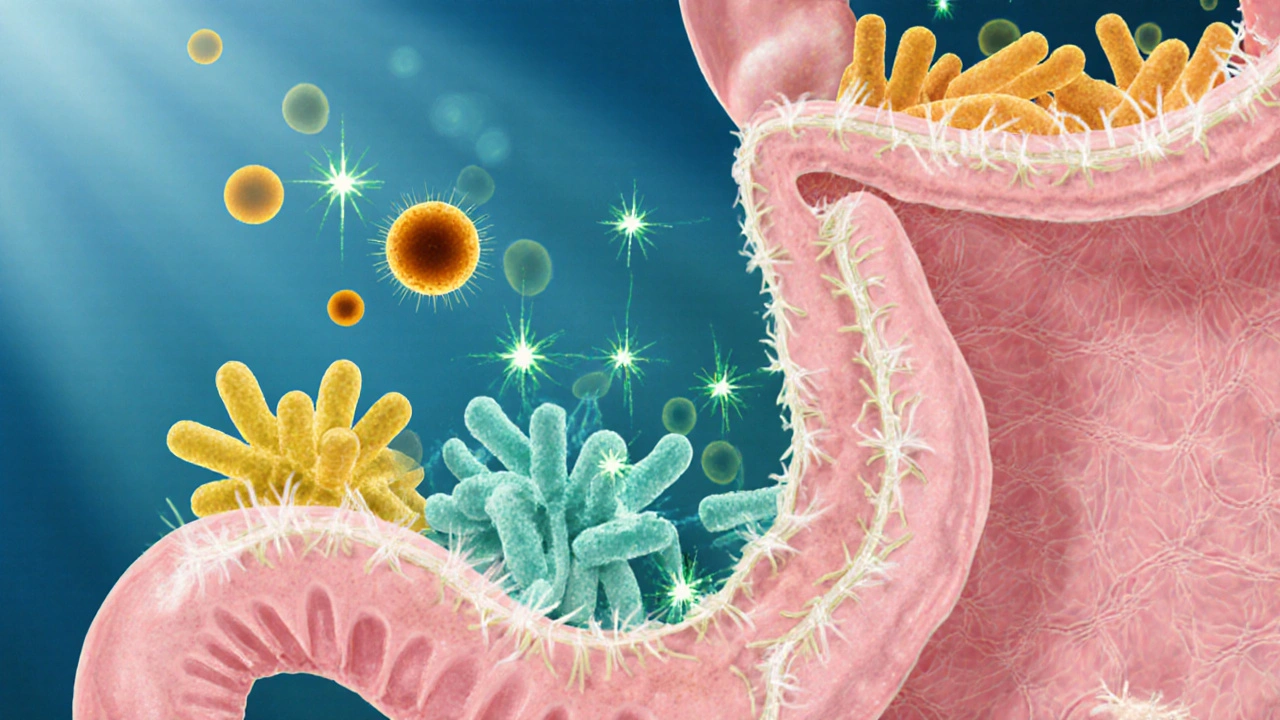
Which Probiotic Strains Have the Best Evidence?
Not every capsule on the shelf is created equal. Here are the strains that have moved beyond “promising” into “clinically supported” for HE:
- Lactobacillus rhamnosus GG (LGG): Reduces intestinal permeability and has been shown in a 2023 double‑blind trial to lower ammonia levels by 18%.
- Bifidobacterium longum BB536: Boosts production of butyrate, a short‑chain fatty acid that fuels colon cells and helps detoxify ammonia.
- Streptococcus thermophilus: Works synergistically with Lactobacillus to ferment lactose, decreasing nitrogen load.
- Clostridium butyricum MIYAIRI 588: Though technically a “good” clostridia, it produces high amounts of butyrate and has a 2024 meta‑analysis backing its use in cirrhosis.
Formulas that combine two or three of these strains tend to outperform single‑strain products.
Probiotics vs. Standard Therapies: A Quick Comparison
| Aspect | Lactulose | Rifaximin | Probiotic Blend (LGG + B. longum) |
|---|---|---|---|
| Mechanism | Acidifies colon, traps ammonia as ammonium | Broad‑spectrum gut‑non‑absorbable antibiotic | Restores beneficial bacteria, reduces ammonia production |
| Typical Dose | 15‑30mL oral solution daily | 550mg twice daily | 1‑2billion CFU twice daily |
| Side‑effects | Flatulence, cramping, diarrhea | Headache, nausea, risk of resistance | Rare bloating; generally well‑tolerated |
| Evidence for HE reversal | Improves symptoms in 60‑70% of patients | Reduces recurrence by ~45% | Improves MMSE by 2‑3 points in 8‑week studies |
| Cost (US, 2025) | ≈$30/month | ≈$150/month | ≈$45/month |
The table shows that probiotics aren’t a magic bullet, but they offer a gentler, cheaper adjunct that can boost the effect of lactulose or rifaximin, especially for patients who can’t tolerate severe diarrhea.
How to Start a Probiotic Regimen Safely
Before you pop a bottle, talk to your hepatologist or gastroenterologist-especially if you have an immune compromise. Here’s a step‑by‑step checklist most clinicians recommend:
- Confirm Diagnosis: Ensure you have a clear HE staging (minimal, grade1‑2, etc.).
- Pick a Clinically Supported Blend: Look for products that list the strains LGG and B. longum on the label, with a total of at least 1billion CFU per dose.
- Check Quality: Choose brands that guarantee viability through expiration (cold‑chain packaging) and have third‑party testing.
- Start Low: Begin with one capsule a day for the first week to gauge tolerance.
- Monitor Symptoms: Track mental clarity, stool frequency, and any abdominal discomfort in a simple journal.
- Adjust Dose: If no side‑effects, increase to two capsules daily after two weeks.
- Re‑evaluate After 8 Weeks: Repeat ammonia levels and neuro‑cognitive testing; discuss results with your doctor.
Most studies report fewer than 5% of participants experiencing mild bloating-usually resolves on its own.

Potential Pitfalls and When Probiotics Might Not Help
Even the best‑studied strains have limits. Keep an eye out for these red flags:
- Advanced HE (grade3‑4): Severe brain edema may need intensive care; probiotics alone won’t reverse coma.
- Recent Antibiotic Course: Broad‑spectrum antibiotics can wipe out the probiotic strains before they colonise.
- Severe Immunosuppression: Although rare, live bacteria can cause opportunistic infections in transplant patients.
If any of these apply, your physician may hold off on probiotics until the acute phase settles.
Bottom‑Line Checklist for Patients and Caregivers
- Ask your doctor if a probiotic blend with Lactobacillus rhamnosus GG and Bifidobacterium longum is appropriate for your HE stage.
- Choose a product with ≥1billion CFU per serving and a clear expiration date.
- Start with one capsule daily, track mental clarity, and increase only if tolerated.
- Keep probiotics as an adjunct, not a replacement, to lactulose or rifaximin.
- Re‑check ammonia levels and mental status after about two months.
Frequently Asked Questions
Can probiotics cure hepatic encephalopathy?
No. Probiotics can lower ammonia and improve cognition, but they work best alongside standard treatments like lactulose. They’re most helpful in mild to moderate HE.
How long should I take a probiotic for HE?
Most clinicians suggest an 8‑week trial, followed by re‑evaluation of ammonia levels and mental status. If you stay stable, many keep the probiotic long‑term as a maintenance strategy.
Are there any foods that act like probiotics?
Fermented foods such as kefir, yogurt with live cultures, and sauerkraut contain beneficial bacteria, but the strains and doses are less predictable than a standardized supplement.
What if I’m already on rifaximin?
Combining rifaximin with a probiotic is common practice. Studies show the combo can lower recurrence rates more than rifaximin alone, without adding major side‑effects.
Is there a risk of infection from taking live bacteria?
In healthy adults the risk is extremely low. Patients with severe immunosuppression should get a doctor’s green light before starting any probiotic.


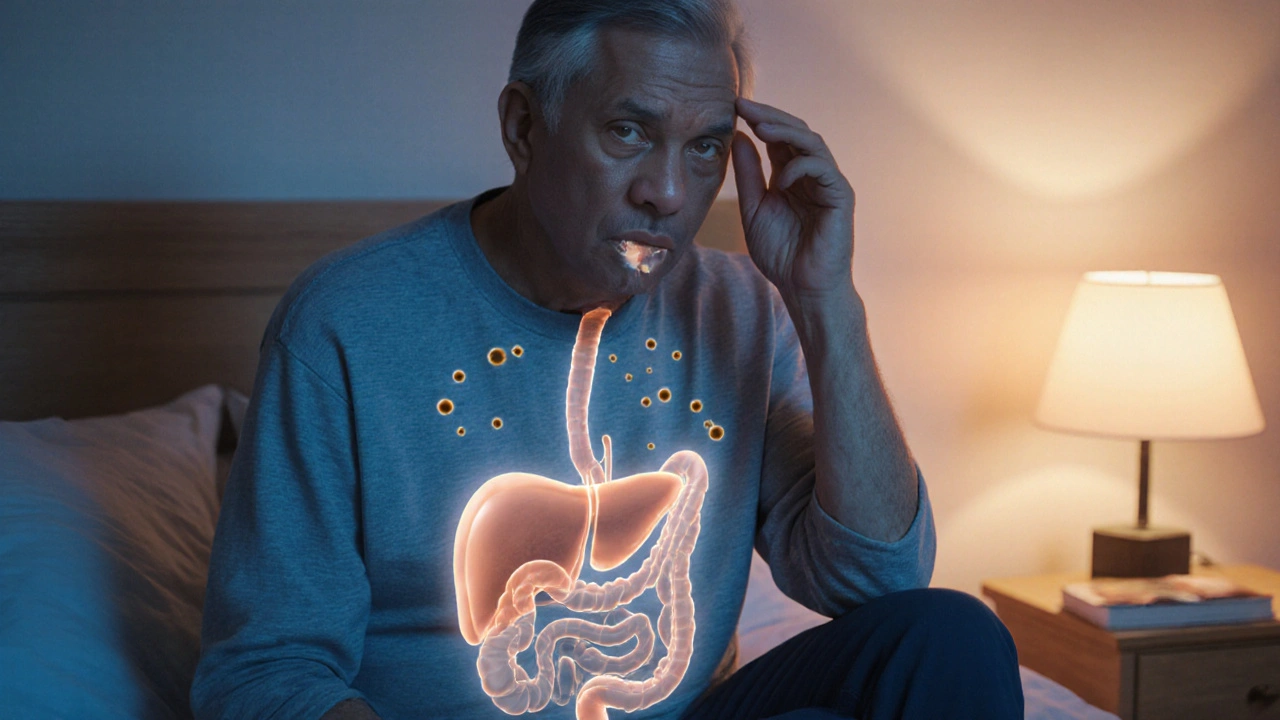
 Medications
Medications
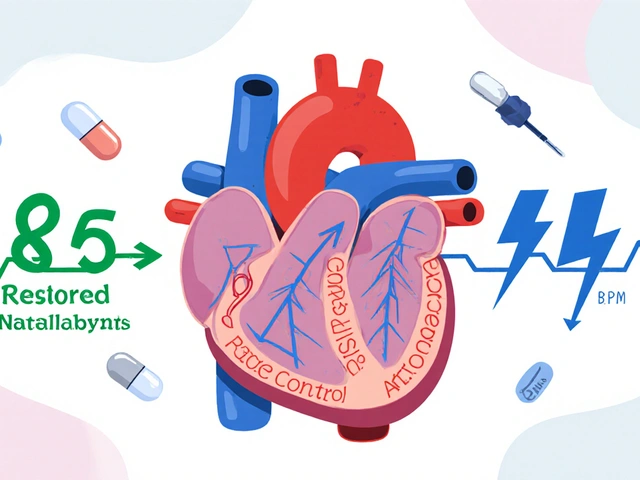
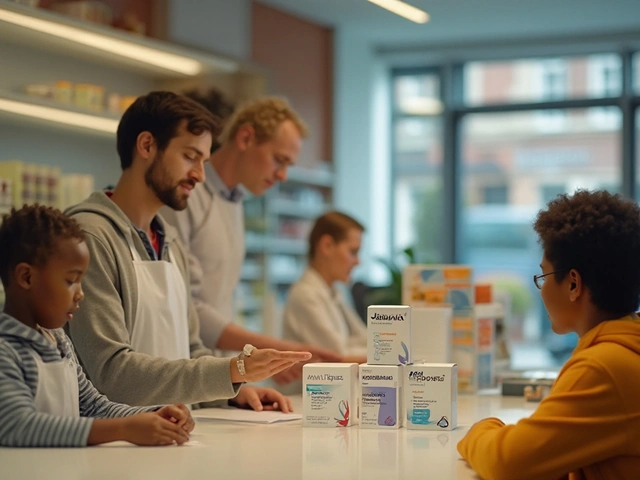
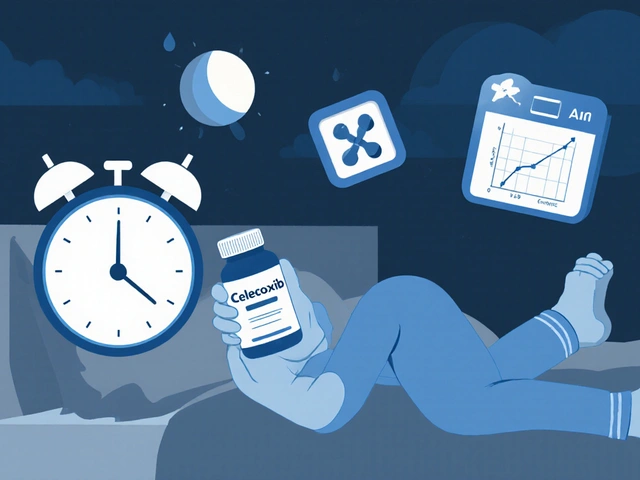


Paul Hill II
October 5, 2025 AT 14:33Probiotics have emerged as a useful adjunct in the management of hepatic encephalopathy, especially when combined with standard therapies like lactulose and rifaximin. The key idea is to modulate the gut microbiome so that ammonia production is reduced and intestinal barrier function is strengthened. Strains such as Lactobacillus rhamnosus GG and Bifidobacterium longum BB536 have been studied in multiple clinical trials, showing modest but significant improvements in mental status scores. In practice, I start patients on a probiotic blend that delivers at least one billion colony forming units twice daily, after confirming that the product lists the specific strains on the label. It is crucial to choose a formulation that guarantees viability through the expiration date, often indicated by a cold‑chain packaging claim. I advise my patients to begin with a single capsule for the first week to assess tolerance, watching for any bloating or mild gastrointestinal upset. If the initial week is uneventful, the dose can be increased to two capsules daily for the remainder of the eight‑week trial period. Throughout this time, I have my patients keep a simple journal noting mental clarity, stool frequency, and any abdominal discomfort, because subjective improvement often precedes measurable changes in ammonia levels. After eight weeks, we repeat laboratory testing and neuro‑cognitive assessments to decide whether to continue, adjust, or discontinue the probiotic regimen. Importantly, probiotics should never replace lactulose or rifaximin in patients with moderate to severe disease; they are meant to complement these agents. For patients already on rifaximin, the combination appears to lower recurrence rates more effectively than rifaximin alone, without adding major side‑effects. In those who cannot tolerate the osmotic effects of lactulose, adding a probiotic may provide some symptom relief while minimizing diarrhea. I always emphasize that any new supplement, even a “natural” one, must be discussed with the hepatology team to avoid interactions and to ensure safety, especially in individuals with immune compromise or recent antibiotic exposure. Finally, cost considerations matter: a quality probiotic blend is typically less expensive than long‑term rifaximin therapy, making it an attractive option for many patients seeking a sustainable adjunct treatment.
Stephanie Colony
October 6, 2025 AT 23:53While the American literature loves to trumpet these probiotic miracle‑cures, let me remind you that most of the robust data come from European and Asian cohorts, not our home‑grown studies. One must be wary of cherry‑picking outcomes that fit a narrative of “holistic” superiority without rigorous, large‑scale US trials to back it up. The exuberant tone of many articles obscures the fact that the effect size is modest at best and often not reproducible in our clinical setting. Moreover, the notion that a cheap over‑the‑counter capsule can replace expensive, FDA‑approved medications is a dangerous simplification that could mislead patients. If you truly care about evidence‑based practice, demand high‑quality, peer‑reviewed US data before recommending probiotics as standard adjunct therapy.
Abigail Lynch
October 8, 2025 AT 09:13There's a hidden agenda behind all this probiotic hype, and it's not just about gut health. Big pharma wants to keep us dependent on pricey drugs like rifaximin, so they subtly discredit natural alternatives, only to later push their own patented probiotic blends that are just as costly. Meanwhile, the media conveniently cites studies funded by the supplement industry, ignoring the possibility of bias. It's almost theatrical how the same experts who warn about antibiotic resistance suddenly become the loudest advocates for these "miracle" microbes. And don't even get me started on the fact that some of these strains are allegedly engineered in labs-who knows what else they're inserting into the mix?
David McClone
October 9, 2025 AT 18:33Ah, the classic conspiracy cocktail, served with a side of drama. Sure, there are conflicts of interest in research, but dismissing every study as a grand scheme is a bit much. Most trials are double‑blind and peer‑reviewed, which reduces, though not eliminates, bias. If you want to be skeptical, focus on the methodology rather than inventing shadowy motives. At the end of the day, patients benefit from any safe, evidence‑backed intervention, regardless of who funded the study.
Jessica Romero
October 11, 2025 AT 03:53From a clinical perspective, the integration of probiotic therapy into hepatic encephalopathy management must be approached with a nuanced understanding of microbiome science and pharmacokinetic interactions. The synergistic effect observed when Lactobacillus rhamnosus GG is co‑administered with lactulose can be attributed to enhanced urease activity inhibition, thereby reducing intraluminal ammonia generation. It is also noteworthy that Bifidobacterium longum BB536 facilitates the production of short‑chain fatty acids, which serve as trophic substrates for colonocytes and reinforce mucosal barrier integrity. When formulating a therapeutic regimen, clinicians should verify that the selected probiotic preparation adheres to Good Manufacturing Practices (GMP) and provides a minimum threshold of viable CFU at the point of consumption, typically quantified via plate‑count assays. Additionally, patient adherence can be optimized by aligning dosing schedules with existing medication timelines, thereby minimizing regimen complexity. In terms of safety profiling, adverse events are largely limited to transient gastrointestinal discomfort, and serious infections remain exceedingly rare in immunocompetent hosts. Nonetheless, a thorough risk assessment is warranted for individuals with profound neutropenia or post‑transplant immunosuppression. Ultimately, while probiotics are not a panacea, their role as an adjunctive modality is supported by a growing body of controlled data, warranting their inclusion in evidence‑based treatment algorithms for mild to moderate hepatic encephalopathy.
Michele Radford
October 12, 2025 AT 13:13Let me be absolutely clear: promoting probiotics as a “harmless” solution while neglecting the moral responsibility of rigorously vetted medical treatments is ethically indefensible. The romanticization of “good bacteria” often masks a lack of accountability when adverse events arise, especially in vulnerable cirrhotic populations. Patients deserve transparent risk‑benefit analyses, not glossy marketing copy that panders to wellness trends. If you truly care about patient welfare, you will prioritize evidence‑based pharmacotherapy over unregulated supplement hype, and you will demand that clinicians disclose any financial ties to probiotic manufacturers.
Mangal DUTT Sharma
October 13, 2025 AT 22:33Hey folks 😊, I totally get the hesitancy around adding another supplement, but I’ve seen some real improvements in my aunt’s clarity when we introduced a high‑quality probiotic blend. The key is to start slow – one capsule a day, watch for any bloating, and then gently increase. It’s also super important to pick a product that guarantees live cultures until the expiration date, otherwise you’re just eating empty capsules. Remember to keep your hepatologist in the loop; they’ll help you track ammonia levels and adjust dosages. And if you’re on lactulose, the combo can really help reduce those gas‑y side effects! 🌟
Gracee Taylor
October 15, 2025 AT 07:53I hear you, and I’m glad you’re approaching this with caution. It’s always best to involve your liver specialist early on, especially when tweaking your regimen. Tracking mental clarity and stool patterns can provide valuable feedback on how well the probiotic is integrating with your current therapy. If you notice any persistent discomfort, don’t hesitate to adjust the dose or try a different strain composition. Ultimately, a collaborative, patient‑centered approach yields the best outcomes.
Leslie Woods
October 16, 2025 AT 17:13Probiotics can help but not cure.
Manish Singh
October 18, 2025 AT 02:33Thats a good pnt i think its importent to keep track of ur mental status and not just rely on labs alot of time the patiets feel beter before the numbers change i have seen that before . also dont forget to tell your doc about the supplemnts you are takign they can give advic if any interacctions happen . its alway good to be open about ur health decissions .
Dipak Pawar
October 19, 2025 AT 11:53From a gastro‑hepatic cultural lens, the integration of probiotic therapy into hepatic encephalopathy protocols reflects a broader shift toward microbiome‑centric paradigms that have deep roots in traditional medicine systems across Asia, where fermented foods have long been used to modulate gut health. In the Indian context, for instance, the concept of “Ama” in Ayurveda parallels the modern notion of toxic metabolites such as ammonia that accrue in dysbiosis. Contemporary research now validates that strains like Lactobacillus rhamnosus GG and Bifidobacterium longum BB536 can attenuate endotoxemia by reinforcing tight junction integrity, a mechanism reminiscent of the Ayurvedic emphasis on “pitta” balance. Moreover, the pharmacoeconomic analysis of probiotic adjuncts demonstrates favorable cost‑effectiveness ratios when juxtaposed against the high expenses of rifaximin, especially in low‑resource settings where healthcare budgets are constrained. It is, however, critical to acknowledge that strain specificity, colony‑forming unit viability, and delivery matrix are pivotal variables that influence therapeutic outcomes; thus, blanket recommendations without consideration of these parameters risk oversimplification. Clinicians should therefore adopt a stratified approach, tailoring probiotic selection to individual patient profiles, disease severity, and existing pharmacotherapy, while maintaining vigilant surveillance for rare but potential translocation events in immunocompromised hosts. In essence, the convergence of ancient wisdom and cutting‑edge microbiology offers a promising adjunctive avenue, provided it is anchored in rigorous clinical validation and culturally sensitive patient education.